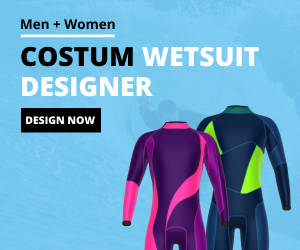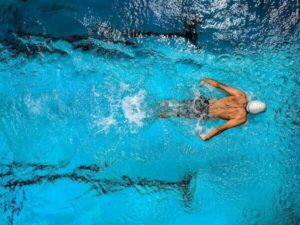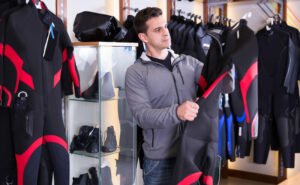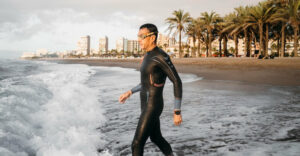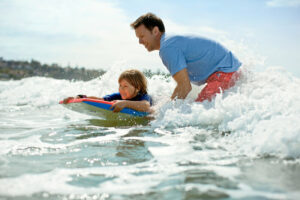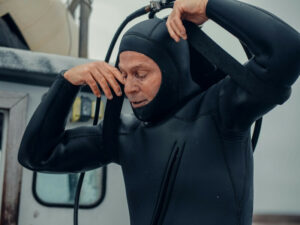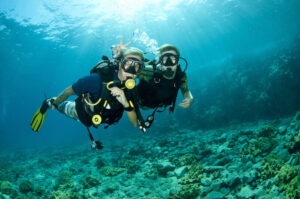Wakeboarding is an adrenaline-filled water sport that combines elements of surfing, water-skiing, and snowboarding, making it one of the most fun ways to experience open water. However, wakeboarding also means exposure to varying water temperatures, wind, and sometimes chilly weather. This is where a good wetsuit comes in—it allows you to enjoy the sport comfortably and safely, even when conditions aren’t warm and sunny. If you are on the search for the best, most comfortable and versatile wetsuits for wakeboarding — this article will give you the answers to all your questions and concerns.
In this article, you will get answers to the following questions:
- What type of wetsuit can you use for wakeboarding?
- Do you need a special wetsuit for wakeboarding?
- What to look for in a wetsuit for wakeboarding?
- Can you wear a drysuit for wakeboarding?
- What are the advantages of a drysuit over a wetsuit when wakeboarding?
Finding the Best Wetsuit for Wakeboarding
When you’re out wakeboarding, you’ll spend a lot of time in the water—especially if you’re still mastering your balance! A good wetsuit offers more than just comfort; it provides thermal insulation, UV protection, buoyancy, and a bit of padding for inevitable falls. This essential gear can greatly extend your time on the water, making your experience more enjoyable.
Since all of these factors are common aspects of all watersports, it is important to understand the main key points of each sport, to define the special needs each wetsuit has to fulfill.
Understanding the Sport: What is Wakeboarding?
The sport has gained immense popularity over the years, attracting enthusiasts of all ages who seek thrills on the water. Over time, even subgroups developed, like wakeboarding vs. wake surfing.
In wakeboarding, the rider is strapped onto a wakeboard, which is attached to a tow-rope. A motorized boat or a mechanical tow construction pull the rider at a speed, typically ranging from 15 to 25 miles per hour (40.23 km/h), depending on the rider’s skill level and preferences.
As the boat or the mechanically towed line moves, it creates a wake, or a series of waves, which the rider can use for tricks and jumps. The skilful use of the wake is essential for performing aerial maneuvers and maintaining balance.
Alternatively, wakeboard parks offer obstacles to ride across or use for jumps — just as in a snowboard park. Beginners usually focus on getting up on the board and maintaining balance in calm water. Once comfortable, riders can progress to practicing simple turns, jumps, and tricks using the wake.
To get started with wakeboarding, you will need a few key pieces of equipment:
- Wakeboard: The board itself is designed to help you glide over the water smoothly. Different boards cater to different styles of riding and skill levels. It is important to find the right wakeboard size for your weight and size.
- Bindings: These are used to secure the rider’s feet to the wakeboard. They come in various sizes and styles to ensure comfort and support.
- Tow Rope: A strong, durable rope is essential for towing the rider behind the boat. The rope usually has a handle for the rider to hold onto.
- Life Jacket and a Helmet: Safety is crucial in wakeboarding. A properly fitted life jacket provides buoyancy and protection in case of falls, while a helmet protects your head from the harsh impact of the water when falling at high speeds or even slower speeds — it still hurts, believe me!
- Wetsuit: Depending on the water temperature, a wetsuit is necessary to keep you warm and comfortable while riding, while keeping your skin protected.
Why is a wetsuit so important for wakeboarding and how important it is to find the right one for your needs? Keep on reading and dive deeper into the topic with us.
Why Should I Wear a Wetsuit for Wakeboarding?
Wetsuits are an essential piece of gear for wakeboarders, providing numerous benefits that enhance comfort and safety on the water. If you’re new to the sport or considering investing in a wetsuit, here are several compelling reasons to don one before hitting the waves:
1. Thermal Insulation
One of the primary functions of a wetsuit is to provide thermal insulation. When you’re wakeboarding, you spend a significant amount of time in the water, which can quickly drain your body heat. A wetsuit traps a thin layer of water between your skin and the suit, which is then warmed by your body heat. This helps keep you warm, even in colder water conditions, allowing you to stay out longer without feeling chilled.
2. UV Protection
Extended exposure to the sun can lead to sunburn, particularly on the water, where reflections can intensify UV rays. Wetsuits offer a layer of protection against harmful UV radiation, helping to shield your skin from sunburn and long-term damage. Wearing a wetsuit can give you peace of mind, so you can focus on enjoying your time on the water without worrying about sun exposure.
3. Buoyancy and Floatation
Wetsuits are designed to provide buoyancy, helping you float more easily in the water. This buoyancy can be especially beneficial for beginners who are still mastering their balance on the wakeboard. Additionally, in case of a fall, the buoyancy of the wetsuit can assist in keeping you afloat, making it easier to recover and get back to the boat.
4. Protection from Falls and Abrasions
Wakeboarding can be a thrilling but challenging sport, and falls are a common part of the experience. A wetsuit offers a layer of padding that can help protect your skin from abrasions and impacts during falls. This extra protection can reduce the likelihood of scrapes, bruises, and other injuries, allowing you to enjoy your sessions with greater confidence.
5. Comfort and Flexibility
Modern wetsuits are designed for comfort and flexibility, allowing for a full range of motion while wakeboarding. High-quality wetsuits are made from stretchy neoprene materials that conform to your body, making it easier to move and maneuver on the board. This added comfort enhances your overall experience, allowing you to focus on your technique rather than feeling restricted by your gear.
6. Extended Water Time
With the protective features of a wetsuit, you’ll likely find yourself wanting to spend more time in the water. Whether you’re practicing tricks, enjoying a leisurely ride, or honing your skills, a wetsuit enables you to comfortably enjoy longer sessions, maximizing your wakeboarding experience.
What type of wetsuit can you use for Wakeboarding?
For wakeboarding, the right wetsuit can really elevate your experience, and it all depends on the water temperature and your own comfort needs. If you’re riding in colder water, a full wetsuit with 3-5 mm thickness will keep you warm, covering you fully from wrists to ankles.
In milder conditions, a spring suit—which has short legs and sleeves—gives you warmth without limiting movement. On warmer days, you might find a sleeveless vest or shorty wetsuit just right, offering more freedom while still adding some warmth and buoyancy.
Look for stretchy, high-quality neoprene for flexibility and comfort, as well as padding to handle any falls. While a swimming wetsuit focuses mostly on buoyancy and freedom of movement, this type of wetsuit can be used for wakeboarding, but a wetsuit that focuses more on padding and warmth will do you much better.
After all, most of your wakeboard experience happens wet but outside the water, which means you will get cold much quicker. And if you are not on top of the water, you will most likely feel deeply thankful for any padding to soften your falls.
Drysuit vs. Wetsuit for Wakeboarding
Choosing between a drysuit and a wetsuit for wakeboarding depends on the water temperature and the kind of feel you prefer on the water.
Can you wear a drysuit for wakeboarding?
A wetsuit is generally the go-to choice for most wakeboarders, especially in moderately cool to warm conditions. It works by trapping a thin layer of water between your body and the suit, which warms up with your body heat.
Wetsuits are made of neoprene, which allows for flexibility and some padding—ideal for movement and handling falls. They come in various thicknesses, usually ranging from 2 mm to 5 mm, so you can decide based on the temperature.
- Pros: Flexibility, comfort, and a good fit; also offers warmth without bulk.
- Best For: Mild to cold waters, especially in the summer and fall.
But still, the choice is up to you: If you prefer the feeling of a drysuit, you should go with your gut. After all, confidence and comfort are the two biggest must haves for any good day in whatever water sport.
What are the advantages of a drysuit over a wetsuit when wakeboarding?
While the wetsuit is the common choice, a drysuit, on the other hand, is designed to keep you completely dry. It has a waterproof seal around the wrists, neck, and ankles, so no water enters the suit. Because it doesn’t insulate with water, you can layer clothes underneath, allowing you to adapt warmth to the conditions.
Drysuits are typically used in very cold water, as they provide more complete protection from cold than even the thickest wetsuit. The fabric is less flexible than neoprene, so it can feel a bit bulkier.
- Pros: Complete dryness and superior warmth in extremely cold conditions.
- Best For: Very cold or icy waters, winter wakeboarding, and prolonged exposure.
If you’re wakeboarding in icy or winter waters, a drysuit is your best bet for staying warm and comfortable. However, for most other conditions, a wetsuit offers the right balance of warmth, flexibility, and freedom of movement, making it the preferred choice for most wakeboarders.
4 Steps: What to Look for in a Wetsuit for Wakeboarding?
Wetsuits work by trapping a thin layer of water between your skin and the suit, which warms up with your body heat, keeping you insulated even in colder conditions. Depending on your personal sensitivity to cold, this makes the thickness of the wetsuit the primary focus for your choice for the right wetsuit for wakeboarding.
Choosing the right wetsuit for wakeboarding is about finding the right balance between warmth, flexibility, and comfort. A suit that’s properly fitted, suited to the temperature, and durable will keep you comfortable and help you enjoy your time on the water to the fullest.
1. Finding the Right Size
For wakeboarding, a wetsuit’s flexibility and fit are critical for comfort and freedom of movement. Since wakeboarding involves dynamic motions and often requires twisting, stretching, and bending, it’s important to have a wetsuit made from highly flexible neoprene. Look for terms like “super-stretch” or “ultra-stretch” neoprene, as these materials adapt to your movements, reducing restriction and fatigue.
Finding the right wetsuit size is not only a question of your height, it includes many measurements, like your arm length, the placement of the zippers and whether you take good care of the wetsuit to avoid stretching and shrinking.
A wetsuit should fit snugly, almost like a second skin, without feeling restrictive. A well-fitting wetsuit keeps a thin layer of water trapped between your skin and the suit, which warms up with body heat and provides insulation. Too tight, and it might feel uncomfortable or restrictive; too loose, and excess water flow reduces insulation, making it less effective.
Consult our ultimate Wetsuit Size Guide to find out which wetsuit size fits your size and needs the best!
2. Thickness and Warmth
The thickness of the wetsuit you need depends largely on the water temperature. A suit between 3 mm to 5 mm is generally good for cooler waters, while a thinner suit around 2mm works for warmer conditions.
For wakeboarding and swimming in icy water, look for glued or taped seams, which prevent water from seeping in, keeping you warmer. Flatlock or stitched seams are often more breathable and work well for milder temperatures.
3. Buoyancy and Padding
Neoprene, the material used in wetsuits, is naturally buoyant, helping you stay afloat. This buoyancy can give you an extra boost when you fall or stop, which can be especially helpful in deep water starts or when you require a quick break.
While it doesn’t replace a life jacket, the buoyancy of a wetsuit offers reassuring support, allowing you to save energy for the board.
The neoprene thickness also provides a cushion, absorbing some impact when you hit the water. A slightly thicker suit in the chest, back, and hip areas can make falls feel softer and reduce bruising. While not specifically designed as protective padding, this added thickness is a bonus for comfort, especially if you’re still working on those new tricks and taking more tumbles than you’d like.
Together, these features make wakeboarding smoother and safer, letting you focus on improving your skills and enjoying the ride!
4. Durability and Quality
When selecting a wetsuit for wakeboarding, durability and quality play essential roles in ensuring a long-lasting, comfortable experience, especially since wakeboarding demands a lot from your body and your wetsuit.
Look for wetsuits made with high-quality neoprene and reinforced seams, such as flatlock or glued and blind-stitched seams. These hold up better against stretching and resist wear from regular exposure to salt, sun, and frequent falls in the water. Reinforced knee and elbow panels add extra protection against friction and impact.
Investing in a well-made wetsuit means more durability, better insulation, and a reliable piece of gear that won’t need constant replacement, giving you peace of mind and comfort as you progress in your wakeboarding journey.
Conclusion: Wetsuits- A Smart Choice for Every Wakeboarder
A wetsuit isn’t a must for wakeboarding, but it can bring a big boost in comfort and safety. While you can ride without one, a wetsuit provides extra warmth, padding, and buoyancy, which can help you stay comfortable in cooler water and cushion falls. It also protects from wind chill, making it easier to enjoy the water for longer. By choosing a wetsuit that fits your needs, you’re free to focus on improving your skills and making the most of every wakeboarding session.
FAQ – Most asked questions about the best wetsuits for wakeboarding:
While a wetsuit is not mandatory for wakeboarding, it significantly enhances comfort and safety. It provides thermal insulation, protects against UV rays, and offers buoyancy, making your time on the water much more enjoyable, especially in colder conditions.
The best type of wetsuit for wakeboarding depends on the water temperature and your personal preferences. A shorty wetsuit is ideal for warm conditions, while a full wetsuit offers better insulation in colder water. Look for suits designed specifically for water sports for added flexibility.
Yes, drysuits can be suitable for wakeboarding, especially in colder climates or during the off-season. They offer excellent thermal protection and freedom of movement, although they may be bulkier than wetsuits. When choosing a drysuit, look for one specifically designed for water sports to ensure flexibility and comfort.



